Tohoku
Golden Week Sakura viewing
Use the navigation bar on the left or the map-links to select a place. Alternatively scroll down to see all the entries. Click on photos to enlarge. See more Tohoku photos here.
I arrived in Tokyo on a warm spring evening. This was the start of the week long national holiday, and what a fine start. I met Tachizaki san and Yoshi san in a 41st floor restaurant with a commanding view over the Tokyo night cityscape. Not only was the view spectacular and the food great, but it was also interesting to find out about the lives of working Japanese people as my friend had recently entered the tax pay world.
At around 11 o'clock I headed for a capsule hotel in Asakusa. En-route I was lucky enough to experience the true crush of the Tokyo subway as thousands of slightly drunken people tried to find their way home. I think the only time that I felt anything even close to this was on the busses in Delhi and getting off at the correct stop was a challenge with a rucksack.
The hotel was again agreeable and I had a long soak in the top floor bath the next morning before hitting the town. This was a brief visit since I've been to Tokyo before, and so I just had a quick look around Senso-Ji, for this is my favourite temple, and then headed for what would be the first of a great number of rail journeys.
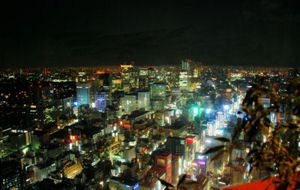 My first stop was city of Sendai, and I opted to take the shinkansen, or bullet train, to save some time and because I could. These are amazing pieces of machinery which impress upon you a feeling of raw-power whilst also appearing elegant with their smooth curves. They are also fast, so I was able to spend much of the day wandering around the temples and gardens of Sendai. Having come from Sapporo, which was just leaving the grips of winter and still sporadically snowing, I was very impressed with the greenness everywhere, and the warmth was very nice.
My first stop was city of Sendai, and I opted to take the shinkansen, or bullet train, to save some time and because I could. These are amazing pieces of machinery which impress upon you a feeling of raw-power whilst also appearing elegant with their smooth curves. They are also fast, so I was able to spend much of the day wandering around the temples and gardens of Sendai. Having come from Sapporo, which was just leaving the grips of winter and still sporadically snowing, I was very impressed with the greenness everywhere, and the warmth was very nice.Matsushima
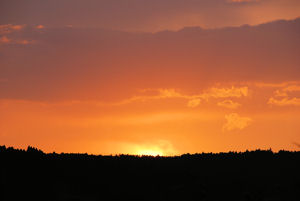 By late afternoon I had seen much of what Sendai had to offer, and so caught a train on to the bay of Matsushima. I arrived an hour or so before sunset and so saw the bay in the glow of the setting sun. Matsushima is one of Japans three most scenic views, with thousands of small limestone islands dotted around a large bay. Since it was Golden Week, I was a little worried that I would not be able to find a place to stay, although in fact I had no problems until the end of my trip. The only budget looking option was situated on a hill outside the town, and upon closer inspection was actually derelict. This left the 2 hotels on the water front, and I chose the one that didn't feature smartly dressed porters. This was a Japanese style hotel with tatami matted floors and a nice communal bath. During the afternoon there had been many snack bars and cafes open along the main front so I opted not to take any meals at the hotel and go into town. However, for some reason it seems that everywhere closes around 6 and so there was only one restaurant to choose from.
By late afternoon I had seen much of what Sendai had to offer, and so caught a train on to the bay of Matsushima. I arrived an hour or so before sunset and so saw the bay in the glow of the setting sun. Matsushima is one of Japans three most scenic views, with thousands of small limestone islands dotted around a large bay. Since it was Golden Week, I was a little worried that I would not be able to find a place to stay, although in fact I had no problems until the end of my trip. The only budget looking option was situated on a hill outside the town, and upon closer inspection was actually derelict. This left the 2 hotels on the water front, and I chose the one that didn't feature smartly dressed porters. This was a Japanese style hotel with tatami matted floors and a nice communal bath. During the afternoon there had been many snack bars and cafes open along the main front so I opted not to take any meals at the hotel and go into town. However, for some reason it seems that everywhere closes around 6 and so there was only one restaurant to choose from.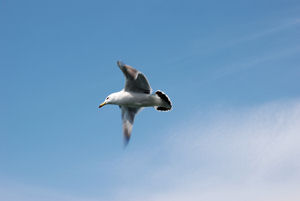 As with much of Japan, the sea food in the area is very fine, and the local speciality was muscles, which were excellent.
As with much of Japan, the sea food in the area is very fine, and the local speciality was muscles, which were excellent.Breakfast is still something I've not adjusted to in Japan. I still like my western cereal, but it's hard to find, and coffee shops don't tend to open until gone 10. In Tokyo I had solved this problem, in the usual tourist way, by visiting Mc Donald's (my travelling treat I like to think, plus it's serves good coffee). However it seems that in Matsushima everybody eats both dinner and breakfasts in the hotels, and since I had already checked out I had to make do with a hotdog and a cake from the only small shop open. But it was a glorious morning and so I sat in the park next to the sea and enjoyed the warm sun. It was still early but the crowds were starting to appear so I quickly dumped my stuff in a locker and set out to take a cruise of the bay.
 The poet Basho was said to be rendered speechless by the beauty of Matsushima. In some ways I feel sorry that he couldn't have lived in our present day. If he liked the bay in the 17th century, then I suspect the idea of taking a cruse on a boat shaped like a dragon or spending an hour hand feeding seagulls prawn flavoured crisps would have truly blown his sandals off. In all fairness, this was actually quite good fun, and the views were very nice - and the boat wasn't too busy, the trips after mine looked crazy - however it wasn't until the afternoon I finally appreciated the true splendour of the bay. To do this I had to find my way along the local rail network then trek for a couple of hours up to a hill which is situated on a peninsular, almost completely surrounded by islands. This mini-expedition started well, as I 'chatted' with an old Japanese man at the train station (my language skills have improved a bit but my bluffing skills have become highly trained).
The poet Basho was said to be rendered speechless by the beauty of Matsushima. In some ways I feel sorry that he couldn't have lived in our present day. If he liked the bay in the 17th century, then I suspect the idea of taking a cruse on a boat shaped like a dragon or spending an hour hand feeding seagulls prawn flavoured crisps would have truly blown his sandals off. In all fairness, this was actually quite good fun, and the views were very nice - and the boat wasn't too busy, the trips after mine looked crazy - however it wasn't until the afternoon I finally appreciated the true splendour of the bay. To do this I had to find my way along the local rail network then trek for a couple of hours up to a hill which is situated on a peninsular, almost completely surrounded by islands. This mini-expedition started well, as I 'chatted' with an old Japanese man at the train station (my language skills have improved a bit but my bluffing skills have become highly trained).
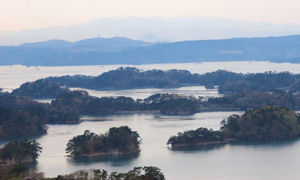
Unfortunately through a translation error he told I wanted a train going in the wrong direction, and so I was stranded in a small village for an hour awaiting a return train. Fortunately I was entertained by a gang of boy racers who were showing off their wheels (and leopard skin shell suits), in the car park next to the station. Several hours later I had made it around the coast and trekked along the beach and up into the hills. I was very surprised to be on my own, and was wondering if I was anywhere near where I was heading when I suddenly summated a rise to find a viewpoint packed with tourists, all of whom seemed to know the short cut. From here the true extent of Matsushima opens up in a quite spectacular fashion, with the green fields beyond briefly separating the sea from the forested mountains.
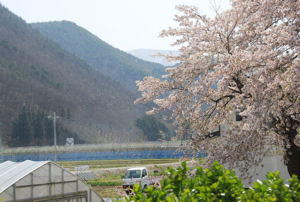
I spent a while here, then walked back to the station, then returned to Matsushima and then Sendai. It seems that most places you can stay in Japan open their doors in the evening, meaning that you can have a full day of sightseeing and then come 8 o clock start the process of finding a place to stay. Since on this trip I was pressed for time and, for once, not money I skipped this by heading out of town and checking into the first business hotel I could find - after some initial exploring it turns out that the prices are pretty uniform and not much more that the Youth Hostels (which are usually inconveniently located miles from anywhere).
Dewa Sanzan
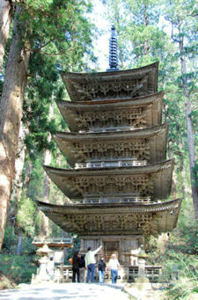
The following day I checked out early and caught a train to Yamagata, this was a nice ride through the Japanese Alps and the cherry blossoms were out in force. I met a couple of Japanese student studying in Sendai and so passed the time quickly. At Yamagata I caught an express bus over some spectacular snow covered mountain and onward to Tsuruoka, where I grabbed a local bus to village of Haguro. The reason for this extensive journey was to see the sacred peaks collectively known as Dewa Sanzan.
I had a late lunch in a small cafe and then set off into the forest to follow the 2446 steps up to the temples at the top of Haguro san. This is a popular pilgrim trail and since the weather was nice the route was busy. There was a nice atmosphere and everyone says konnichiwa to one another as they passed, a small boy even wished me good luck as he ran past. There is a Shinto tradition to rebuild temples from scratch every 20 years using the same ancient know-how. This means that often temples look quite new and it is hard to grasp the timelessness that is so apparent in other parts of the world. However, the path through the forest was lined with mighty trees over 50 meters high, and this truly impresses how ancient these trail are. Since it was still out of season, with snow at the top, there wasn't much going on at the summit so after an ice cream I started the decent back to the village.
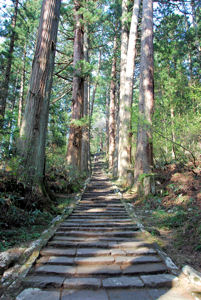 I went back on the road in the vague hope of getting a lift, and within a minute someone pulled over and asked where I was going.
He seemed very amused at my (lack of) language skill and that I could only read the numbers on his business card - these were in the Chinese kanji I might add and his name featured none of the most common symbols - and even more amused at the fact that I didn't know where I was going to stay. Haguro is famous for its temple inns, of which there is a whole district so I felt there wouldn't be too much difficulty; however my new found friend effectively communicated through more raucous laughter that there was no chance of me picking up a room for under 50 pound. I might not have been on a budget but this seemed a little excessive, and most of the places looked like quite modern houses, not traditional temples as I'd hoped, so I decided to get a bus back to Tsuruoka. With an hour to kill I headed back to the cafe where I had had lunch. The old lady sitting out front kindly gave me all the green tea I could drink in exchange for a chat about the weather, one of the few conversations I'm proficient at.
I went back on the road in the vague hope of getting a lift, and within a minute someone pulled over and asked where I was going.
He seemed very amused at my (lack of) language skill and that I could only read the numbers on his business card - these were in the Chinese kanji I might add and his name featured none of the most common symbols - and even more amused at the fact that I didn't know where I was going to stay. Haguro is famous for its temple inns, of which there is a whole district so I felt there wouldn't be too much difficulty; however my new found friend effectively communicated through more raucous laughter that there was no chance of me picking up a room for under 50 pound. I might not have been on a budget but this seemed a little excessive, and most of the places looked like quite modern houses, not traditional temples as I'd hoped, so I decided to get a bus back to Tsuruoka. With an hour to kill I headed back to the cafe where I had had lunch. The old lady sitting out front kindly gave me all the green tea I could drink in exchange for a chat about the weather, one of the few conversations I'm proficient at.
The following day I planned to climb the largest of the sacred mountains, known as Gas san. From the day before I knew that the express bus stopped at a place that looked close by. There was still quite a bit of snow around, however, the ridges had looked fairly clear so I figured it might be ok.
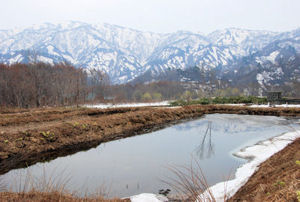 What I didn't really appreciate was how far away from the mountain the bus dropped me and after a few hours of walking along roads and snow covered tracks I realised it was an impossibility to even reach the base of the mountain and had to turn back. Even so, this was a nice enough walk as the region has many lakes. It perhaps should be noted that the lakes only exist due to massive damming projects, for a country whose national religion is Shinto, it is a little surprising that nearly every river in the country is dammed and that there are at least 10 miles of tunnel on the one road I took through some of the most sacred mountains. It would have been interesting to visit Japan in the 50's when it must have been like the China of today, only perhaps even more intense due to the small amount of available land.
What I didn't really appreciate was how far away from the mountain the bus dropped me and after a few hours of walking along roads and snow covered tracks I realised it was an impossibility to even reach the base of the mountain and had to turn back. Even so, this was a nice enough walk as the region has many lakes. It perhaps should be noted that the lakes only exist due to massive damming projects, for a country whose national religion is Shinto, it is a little surprising that nearly every river in the country is dammed and that there are at least 10 miles of tunnel on the one road I took through some of the most sacred mountains. It would have been interesting to visit Japan in the 50's when it must have been like the China of today, only perhaps even more intense due to the small amount of available land.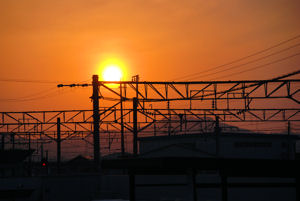 That evening I headed back to Tsuruoka, unsure exactly what my next move would be. The Tohoku region is sometimes referred to as the Japanese Deep South (well that's what Lonely Planet says), being the region where much of the nations rice is grow, and is viewed as undeveloped and less industrial than much of the rest of Japan. Tsuruoka is a small town near the end of a slow local train network, and I think it says something about the Asian 'miracle' economic to say that there is probably more heavy industry in this town than I've seen in say The Midlands. Beyond quite a nice temple and solitary cherry tree I couldn't find any great reason to stay in Tsuruoka a second night so instead I caught the train to the town of Sakata. I liked Sakata instantly, partly because it was by the sea so had fresher air and partly because the kanji for its name means sake rice field.
That evening I headed back to Tsuruoka, unsure exactly what my next move would be. The Tohoku region is sometimes referred to as the Japanese Deep South (well that's what Lonely Planet says), being the region where much of the nations rice is grow, and is viewed as undeveloped and less industrial than much of the rest of Japan. Tsuruoka is a small town near the end of a slow local train network, and I think it says something about the Asian 'miracle' economic to say that there is probably more heavy industry in this town than I've seen in say The Midlands. Beyond quite a nice temple and solitary cherry tree I couldn't find any great reason to stay in Tsuruoka a second night so instead I caught the train to the town of Sakata. I liked Sakata instantly, partly because it was by the sea so had fresher air and partly because the kanji for its name means sake rice field.  This conjures up some great images but as far as I could tell the rice paddies leading up to the town were filled water, rice and trackers, not strong alcohol. Whist I had had trouble finding a place to eat in Tsuruoka, there were plenty of options here and I opted for a local Ramen shop filled with ancient looking pans and a till so old it was probably an antique. This shop was the only point on my trip where I felt I found some remnants of the old Japan, or at least an image of what I would expect the pre-super-industrial Japan to be like; something which I had been hoping to glimpse on this trip.
This conjures up some great images but as far as I could tell the rice paddies leading up to the town were filled water, rice and trackers, not strong alcohol. Whist I had had trouble finding a place to eat in Tsuruoka, there were plenty of options here and I opted for a local Ramen shop filled with ancient looking pans and a till so old it was probably an antique. This shop was the only point on my trip where I felt I found some remnants of the old Japan, or at least an image of what I would expect the pre-super-industrial Japan to be like; something which I had been hoping to glimpse on this trip.While Sakata seemed nice, there were many places I wanted to visit and I was aware that I was limited to a few days, so after a quick stroll the next morning I headed on to Akita. This was a great journey with the small two carriage train crawling between steep sided hills. Whenever the land smoothed sufficiently, small villages and rice paddies occupied every inch, and every so often the train line skirted along the edge of the sea.
Akita is famous for having the most beautiful women in Japan; which is said to be because it has the most pleasant weather and the people eat mostly wheat. By pleasant weather one presumes the meaning is rain, which was plentiful, and seemed to have deterred the beautiful woman from wandering the park with me to look at the somewhat waterlogged blossoms. And so after lunch I continued to the town of Kakunodate via another quick bullet train ride.
Kakunodate
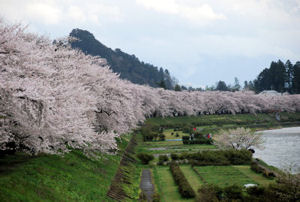
Kakunodate is famous for two things. Firstly the town is still in an old style feudal layout, complete with samurai district, and second, along the river is an impressive stretch of cherry trees, spanning the good part of a mile. The rain had stopped, and briefly the sun even tried to shine, so it was pleasant afternoons wander. After seeing the cherry blossoms here, the bar was raised somewhat for the rest of Japan, and later I would find myself looking with almost indifference at blossoms more spectacular than I would ever hope to see in England. Since it was golden week there was the usual range of food stalls by the river, and so I collected a range of things on sticks and then spent the rest of the afternoon perusing one of my new found hobbies - looking for a bin. This I really don't understand. Everything in Japan comes pre-wrapped, or on a stick or in paper, and yet there are almost never bins to be found. What's more confusing is that there is rarely any litter lying around, and yet no one else seems to suffer from this problem. After seeing some samurai houses and exploring the rest of the town I caught a train to Morioka.
Morioka
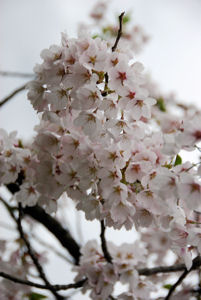
It was dark by the time I arrived so I scoured the skyline carefully on the way into town to note the positions of the cheap hotels - which advertise their prices in large fluorescent letters. After dumping my stuff in a quite agreeable place I headed back to the city centre. Morioka has quite a cosmopolitan feel to it, and the centre is full of cafes and sandwich bars. These, of course, were all closed in the evening but I found an agreeable Ramen shop on the outskirts which sold a good curry. Morioka was also packed with foreigners - I counted at least 5 around the city centre and I met an Australian guy who had seen me and guessed the people in the Raman shop spoke English, which lead to some confusion. It had only been a few days, but it was still nice to speak to someone in English so we chatted away and then explored what Morioka had to offer by way of bars, I'm guessing we went the wrong was as it seemed a little limited.
The following day would turn out to be rather long, but it started well when I discovered my hotel provided a free, and quite excellent, breakfast, complete with free use of the coffee machine. I walked along the river where there were many flowers and some young kids chasing ducks. It still surprises me to see kids out on their own.
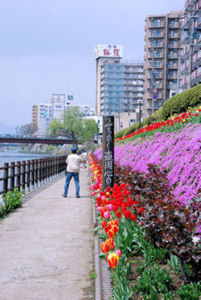 In the West the fear of them being abducted or falling in the river etc would mean that there would always be a grown up present, but these two were both only about 4 years old and completely on their own, and this is not an uncommon sight and kid don't seem to mind wandering off on their own. It says something about how safe this country is and how much respect for one another, and especially for children, there is. I have read that some of this is due to the presence of the Japanese Mafia, which strongly discourages others committing crimes, and infringing on their business, by killing them. Certainly some of the politeness within Japanese society finds it routs in the strict codes of ancient times, but whatever the reason it is certain the West can learn a lot from it.
In the West the fear of them being abducted or falling in the river etc would mean that there would always be a grown up present, but these two were both only about 4 years old and completely on their own, and this is not an uncommon sight and kid don't seem to mind wandering off on their own. It says something about how safe this country is and how much respect for one another, and especially for children, there is. I have read that some of this is due to the presence of the Japanese Mafia, which strongly discourages others committing crimes, and infringing on their business, by killing them. Certainly some of the politeness within Japanese society finds it routs in the strict codes of ancient times, but whatever the reason it is certain the West can learn a lot from it.Along the river's edge were also vast numbers of tulips, and this is another thing that has surprised me. There are more tulips in this country than I've ever seen elsewhere else, and yet it has never been mentioned in a guide book or even in conversation. Partly this could be because usually they are bought and planted when just about to flower, but mostly I think it is because of the complete monopoly on flowers that the cherry (and peach) blossoms command. Midmorning I went to the train station to see about catching a train on to the famous town of Hirosaki.
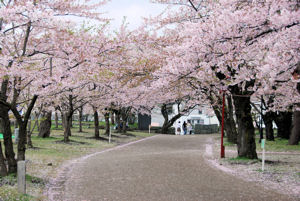 Unfortunately, I just missed my connection at Odate and so finally crawled into Hirosaki around half 5. Hirosaki is famous for both its castle and cherry blossom, and the town was incredibly busy. There was a long queue at the tourist information but on the way in I had seen many cheap looking hotels, so figured there would be no problem. However, I though I should probably find a place to stay before exploring the area, so set off into town. Twenty minuets later I was heading back to the information kiosk and 10 minuets after that I was boarding an ongoing train to the prefecture capital, Aomori - there was not a single bed left in the whole city. The hour or so ride passed quickly in the company of 5 extremely excitable college girls who were keen to show off their range of random English word and phrases, featuring 'how do you do', 'haemoglobin'. The train pulled into Aomori around seven thirty and after 4 hours I had searched most of the sleeping possibilities and discovered that there was not a single bed to be had in this city either.
Unfortunately, I just missed my connection at Odate and so finally crawled into Hirosaki around half 5. Hirosaki is famous for both its castle and cherry blossom, and the town was incredibly busy. There was a long queue at the tourist information but on the way in I had seen many cheap looking hotels, so figured there would be no problem. However, I though I should probably find a place to stay before exploring the area, so set off into town. Twenty minuets later I was heading back to the information kiosk and 10 minuets after that I was boarding an ongoing train to the prefecture capital, Aomori - there was not a single bed left in the whole city. The hour or so ride passed quickly in the company of 5 extremely excitable college girls who were keen to show off their range of random English word and phrases, featuring 'how do you do', 'haemoglobin'. The train pulled into Aomori around seven thirty and after 4 hours I had searched most of the sleeping possibilities and discovered that there was not a single bed to be had in this city either.
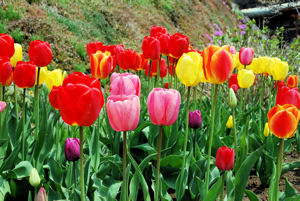
This left the options at park bench or an all night bar, neither of which seemed to appeal too much in the drained state I was in, so when I noticed there was a train heading for home leaving at midnight I opted to cut the trip short and spend the night sitting on a train watching the night role by. Maybe next golden week I will be more organised, or just go somewhere less popular.
Aomori
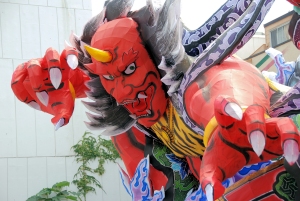 Myself, Thomas and Leticia arrived in Aomori for the final day of the big Nabuta festival near the beginning of August, 2008. Having got the night train from Sapporo we arrived around 6 a.m., to find the remains of the previous night party being cleared away and the last of the festival goers heading off for a few hours sleep - Nebuta is the biggest festival in Aomori and every night for the last there had been processions and partying in the streets. Only on the final day the festival is performed in the daytime and this is what we had come to see. With some time on our hands we wandered the town as it began to come to life, with people out in the parks doing tai-chi and the market sellers stacking their wares. After coffee we headed for a brief excursion to outskirts of the city to the site of a village dating back several thousand years. Little is know of the Jomon civilisation in Japan, the most ancient of the islands people, so this site holds much interest, however it seems that based on a few artefacts quite a staggering number of reconstructions had been made.
Myself, Thomas and Leticia arrived in Aomori for the final day of the big Nabuta festival near the beginning of August, 2008. Having got the night train from Sapporo we arrived around 6 a.m., to find the remains of the previous night party being cleared away and the last of the festival goers heading off for a few hours sleep - Nebuta is the biggest festival in Aomori and every night for the last there had been processions and partying in the streets. Only on the final day the festival is performed in the daytime and this is what we had come to see. With some time on our hands we wandered the town as it began to come to life, with people out in the parks doing tai-chi and the market sellers stacking their wares. After coffee we headed for a brief excursion to outskirts of the city to the site of a village dating back several thousand years. Little is know of the Jomon civilisation in Japan, the most ancient of the islands people, so this site holds much interest, however it seems that based on a few artefacts quite a staggering number of reconstructions had been made.
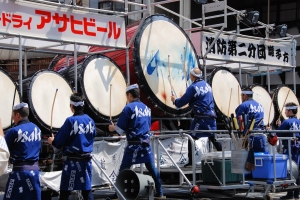 The most striking in the centre piece of the site which looks like a large climbing frame and is based solely on the knowledge that 6 large posts had at one time stood there. However, the reconstructed huts where nicely done and it was possible to see the real excavations inside refrigerated warehouses. There may have been more to see here but we did not want to miss any of the festival so headed quickly back into town to grab some lunch and find a place to watch.
The most striking in the centre piece of the site which looks like a large climbing frame and is based solely on the knowledge that 6 large posts had at one time stood there. However, the reconstructed huts where nicely done and it was possible to see the real excavations inside refrigerated warehouses. There may have been more to see here but we did not want to miss any of the festival so headed quickly back into town to grab some lunch and find a place to watch.
The Nebuta festival is as good as I had been told. People pull floats around the central streets of the town, each of which is very large and exquisitely detailed. I'm not sure what the floats signify but I think there are gods, warriors and animals, probably depicting different legends and stories.
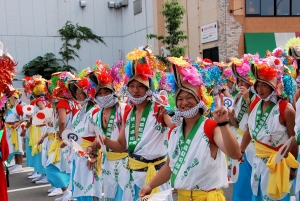 What is impressive is the shear size of the floats as well as the number of them. Each is pulled by a team of perhaps 40 people with other banging drums and playing instruments while yet more sing and dance. I think the previous week of performing the festival each evening (where all the floats are lit internally - something I would love to see another time) had taken its toll on the people of Aomori as many looked rather tired, but everyone was putting everything into it, even though it was an extremely hot and sunny day, and made fore a really enjoyable day. I think this is certainly my second favourite festival after Yosakoi and Thomas said he even preferred it.
What is impressive is the shear size of the floats as well as the number of them. Each is pulled by a team of perhaps 40 people with other banging drums and playing instruments while yet more sing and dance. I think the previous week of performing the festival each evening (where all the floats are lit internally - something I would love to see another time) had taken its toll on the people of Aomori as many looked rather tired, but everyone was putting everything into it, even though it was an extremely hot and sunny day, and made fore a really enjoyable day. I think this is certainly my second favourite festival after Yosakoi and Thomas said he even preferred it.
After a few hours the parade finished and immediately the floats were taken away to be dismantled, with the smaller painting being handed out to the public. On the way over I was asked to do some translation by some hairdressers for a polish guy who wanted his hair cut. In exchange we were given beer which saved us finding a pub so we went over to the harbour where the food stalls were setting up before the evening fireworks.
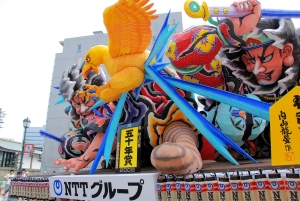 As ever, it seems, the accommodation is Aomori is booked out fast. Even 2 weeks before it was impossible to find anywhere and so we had to go to Hirosaki, an hour away by train. Having been up since 6 we headed off before the fireworks and in Hirosaki I said farewell to the other and found my capsule hotel, which was rather excellent.
As ever, it seems, the accommodation is Aomori is booked out fast. Even 2 weeks before it was impossible to find anywhere and so we had to go to Hirosaki, an hour away by train. Having been up since 6 we headed off before the fireworks and in Hirosaki I said farewell to the other and found my capsule hotel, which was rather excellent.
This was the first day of my month long trip through Japan and Korea on my way home, and no finer start could really be asked for.